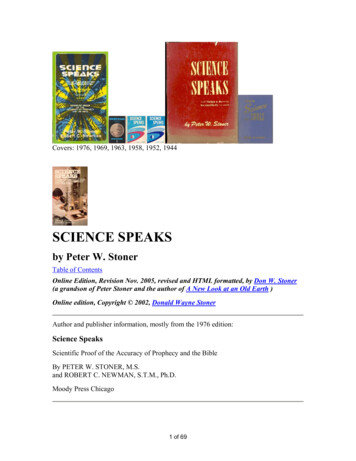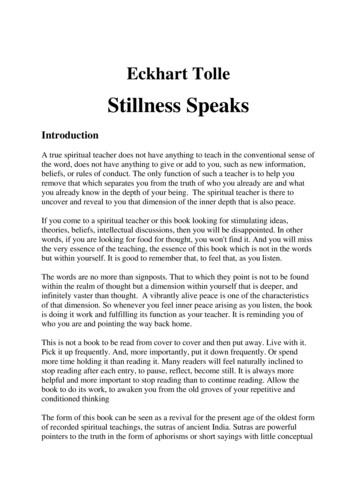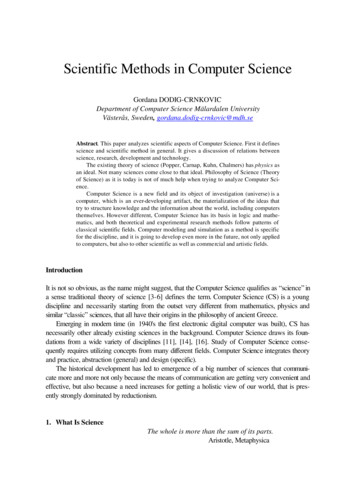
Transcription
Covers: 1976, 1969, 1963, 1958, 1952, 1944SCIENCE SPEAKSby Peter W. StonerTable of ContentsOnline Edition, Revision Nov. 2005, revised and HTML formatted, by Don W. Stoner(a grandson of Peter Stoner and the author of A New Look at an Old Earth )Online edition, Copyright 2002, Donald Wayne StonerAuthor and publisher information, mostly from the 1976 edition:Science SpeaksScientific Proof of the Accuracy of Prophecy and the BibleBy PETER W. STONER, M.S.and ROBERT C. NEWMAN, S.T.M., Ph.D.Moody Press Chicago1 of 69
Peter Stoner, June 16, 1888 - March 21, 1980PETER W. STONER, M.S.Chairman of the Departments of Mathematics and Astronomy at Pasadena City Collegeuntil 1953; Chairman of the science division, Westmont College, 1953-57; ProfessorEmeritus of Science, Westmont College; Professor Emeritus of Mathematics andAstronomy, Pasadena City College.ROBERT C. NEWMAN, S.T.M., Ph.D.Ph.D. in Astrophysics, Cornell University, 1967; S.T.M., Biblical School of Theology,1972; Associate Professor of Physics and Mathematics, Shelton College, 19689-71;Associate professor of New Testament, Biblical School of Theology, 1971Science Speaks, by Peter W. Stoner. Copyright 1958, 1963, 1968 by the Moody BibleInstitute of Chicago. Manufactured in the United States of America. All rights reserved.Revised, 1976On-line HTML revised edition 2002Moody press, a ministry of the Moody Bible Institute, is designed for education,evangelization and edification. If we may assist you in knowing more about Christ andthe Christian life, please write us without obligation to: Moody Press, c/o MLM,Chicago, Illinois 60610.SCIENCE SPEAKSby Peter W. StonerIn this revised edition of Science Speaks Professor Stoner examines the findings ofscience and the Genesis account of creation. He considers the day by day order ofcreation and shows the accuracy of Moses' record. The well-accepted principle ofprobability is applied to Bible prophecy. A fascinating discussion centers aroundEzekiel's prophecy concerning Tyre, Micah's predictions about Samaria, and Jeremiah's2 of 69
utterances dealing with Moab, Ammon and Babylon. Attention is given to Old Testamentprophecy which finds fulfillment in the life and ministry of Jesus Christ.The attack by critics of the Bible has often come in the name of science. Faith has beenthreatened because the Bible has been thought to be in serious error. Today, through theefforts of Christian scientists, items of conflict between science and the scriptures arebeing harmonized. The evidence continues to accumulate in favor of the Bible as theproduct of Divine intelligence. Science Speaks is an enlightening comparison of Biblicaltruth and the established scientific data.SCIENCE SPEAKSby Peter W. StonerCONTENTS. Forward, by H. HAROLD HARTZLER, Ph.D. Preface. Introduction1. Changes in Science. I. Scientific Accuracy. II. Powers of God. III. Scientific Problems Discussed2. Prophetic Accuracy3. The Christ of Prophecy4. Conclusions. Appendix 1: Preface to the 1944 Edition. Appendix 2: Other Interpretations of Genesis. Appendix 3: A Challenge to Critics of Chapter 3, By Don Stoner. FootnotesFOREWORDThe manuscript for Science Speaks has been carefully reviewed by a committee of theAmerican Scientific Affiliation members and by the Executive Council of the same groupand has been found, in general, to be dependable and accurate in regard to the scientificmaterial presented. The mathematical analysis included is based upon principles ofprobability which are thoroughly sound and Professor Stoner has applied these principlesin a proper and convincing way.American Scientific AffiliationH. HAROLD HARTZLER, Ph.D.Secretary-TreasurerGoshen College, Ind.3 of 69
PREFACEA generation ago (that is, a "generation" before Science Speaks was originally published,in 1952, by Van Kampen Press - Editor) there were dire discrepancies between Genesis 1and the findings of science, and especially was this true of astronomy. The attack of thecritic came primarily through the sciences, and the faith of many young people waswrecked because they thought the Bible was in serious error and therefore could nolonger be trusted.Since that time, tremendous advances in the sciences have taken place. One by one theitems of conflict between science and the Genesis account were harmonized. Today thelast serious point of conflict between the Scriptures and science has not only beenharmonized, but the findings of science stand ready to supply tremendous evidence thatthe Bible could not possibly have been written representing the education and culture ofthat day.Today, if our young people are properly taught in the churches, there is no possibleexcuse for losing their faith in college, for everything that they study in the physicalsciences will speak of the unerring truth of the bible. If they will stop to consider, it willprove to them that God alone could have been the Author of the Bible.It is the purpose of this book to lay side by side the findings of the physical sciences andthe statements of the Scriptures, so that anyone may observe their miraculous agreement.In setting up these relations, the scriptural statements have been taken exactly as they aregiven, neither adding to nor subtracting from them. No scriptural statement has beentaken out of its context. No wild scientific theory has been introduced to explain ascriptural account. Only the best modern scientific material has been used. This scientificmaterial would be accepted in any college science class.We might define science as "the result of the attempt of man to determine what God didin the creation and what laws He laid down."Science is ever advancing, and during the last few years there has been a tremendousacceleration. It is not the thought of the authors that this book is the final word on thecorrelation of the sciences and the Scriptures. They do believe that, as science advancesstill more, these correlations will be greatly improved and made still more positive.It is the intention of the authors to cite only a few of the correlations between science andthe Scriptures which they consider to be most vital in establishing the miraculousreliability of the Scriptures. It would require many specialized authors filling manyvolumes to adequately cover the whole field.The references given are in no wise inclusive. They are only those which happen to be onthe authors' desks, or are most easily available to them. If the reader does not have a goodscientific background he should carefully examine all of these or similar references.INTRODUCTION4 of 69
ON MY DESK I have Young's General Astronomy (1898). Many changes have takenplace in astronomy since this was the standard college text of our country. This bookindicates that the heat from the sun comes from its cooling off. Science now believes thatthe heat of the sun comes from its changing some 4,200,000 tons of matter into energyeach second. Young teaches that the solar system was formed according to the NebularHypothesis. That is, that our solar system started as a flat disc-shaped body of gas, that itshrank and speeded up as it cooled off, leaving small parts of itself behind to form theplanets, and that the main central part became the sun. This theory today is discredited.1Young believed the dark spots in the sky to be holes through which we looked into emptyouter space. We now know most of these to be dark nebulas. Young tells us that all spiralnebulas are gaseous bodies in our own galaxy. We now know them to be galaxies, greataggregates of stars for out in space from our own galaxy. Young knows of nothingbeyond our galaxy but outer empty space. We know now that there are billions andperhaps trillions of other galaxies. In fact Young's book is of relatively little value whenit treats of things far from our own solar system.Texts of astronomy two hundred years old are very entertaining, but in the light ofpresent-day knowledge nearly everything is in error.Genesis 1 is not just one or two hundred years old; it is several thousand years old. If itwere written by man, representing the scientific ideas of that time, we should expect tofind most of its definite statements in error. If we find them all verified by the best of ourscience today, we shall be certain that Genesis does not present the beliefs and culture ofthe day in which it was written.AND OLD BATTLEGROUNDGenesis 1 has for generations been the ground for criticism of the Bible and of attacks onits authenticity. Let us carefully examine its statements, for it is in this chapter that Godmakes His main claims to His acts of creation. It will be necessary to read carefully andto analyze the account just as it is given---neither reading into the account things that arenot there, nor omitting things which are definitely stated.There are thirteen acts very definitely named in this chapter. God claims in some placesto have "created," in other places to have "made," and in still other places He uses theword "let." God also claims to have done these things in a very definite order. We shallbe very much concerned with this order, for this account was written long beforescientific information was available to guide the writer of Genesis.There is often disagreement regarding the date of writing Genesis 1. I shall not enter intoa discussion of this subject, for while I have very definite ideas on it, the subject can in noway affect the present consideration. None of the scientific evidences which I shall usewas established by science even within one thousand years of the latest date everproposed for the writing of Genesis, and much of the scientific information was not evenknown as recently as the early 1900s. It is evident, therefore, that if this material inGenesis agrees with modern science, the agreement did not come from scientificknowledge when the Bible was written. Reference to the teachings of Egypt, Babylon,and other ancient civilizations regarding their theories of creation is found here.5 of 69
CHAPTER 1CHANGES IN SCIENCEI Scientific AccuracyBe ready always to give an answer to every man that asketh you a reason of the hope thatis in you - I Peter 3:15.THIRTEEN DEFINITE CLAIMSTHE FOLLOWING THIRTEEN EVENTS will be found in Genesis 1 as having beenaccomplished in the order given:1. "In the beginning God created the heaven and the earth" (v.1).2. "And the earth was without form, and void; and darkness was upon the face of thedeep" (v.2).3. "And the Spirit of God moved upon the face of the waters" (v.2).4. "And God said, Let there be light . and God divided the light from the darkness. AndGod called the light Day, and the darkness he called Night" (vv. 3-5).5. "And God made the firmament, and divided the waters which were under thefirmament from the waters which were above the firmament" (v. 7).6. "And God said, Let the waters under the heaven be gathered together unto one place"(v. 9).7. "And let the dry land appear" (v.9).8. "And God said, Let the earth bring forth grass, the herb yielding seed, and the fruit treeyielding fruit after his kind" (v. 11).9. "And God said, Let there be lights in the firmament of the heaven to divide the dayfrom the night; and let them be for signs, and for seasons, and for days, and years. " (vv.14-18).10. "And God created great whales, and every living creature that moveth, which thewaters brought forth abundantly, after their kind" (v. 21).11. "And every winged fowl after his kind" (v. 21).12. "And God said, Let the earth bring forth the living creature after his kind, cattle, andcreeping thing and beast of the earth after his kind" (v. 24).13. "So God created man in his own image" (v. 27).We shall now discuss these claims one by one.1. The Physical UniverseThe first claim of Genesis is that God created the physical universe. In the late 1800s, thiswas considered absurd. Chemistry taught that matter was eternal; it could neither bedestroyed nor created. It taught that you could change the form of matter, formingcompounds or breaking down those already formed, but that all of the matter was still inexistence as matter. It is clearly seen that if matter can neither be destroyed nor created, aserious question would be thrown on this first verse.6 of 69
At this same time it was thought that the sun's source of heat came from the sun's coolingoff. It was thought that the sun must have started as a very large body. perhaps largeenough to include all of the planets and it was cooling off and shrinking in the process offorming the solar system. If the sun even started as large as the whole solar system andwas extremely hot it would have cooled down to its present temperature and size in asmall fraction of the time that we even then knew as the necessary age of the earth. So wehad to look for other sources of the sun's heat.The possibility of actual combustion taking place in the sun was considered. Possibly thesun was composed of something like anthracite coal and it was burning to produce thesun's heat. But again if the sun were to start as large as the whole solar system and bemade of the best coal it would have burned down to its present size in too short a time tobe a possible answer.This forced us to still another consideration. It was known that there were such things asradioactive elements, and that they gave off energy as they changed to other elements.This came into popular favor with Einstein's formula, E mc2, where E is the energy inergs, m the mass in grams, and c the velocity of light in centimeters per second. In thisformula c equals approximately 3 x 1010 cm/sec., or c2 equals 9 x 1020 or 9 followed by20 zeros. Thus a small amount of mass produces a tremendous amount of energy. Thisformula not only supposes that matter can be changed into energy, but shows the exactamount of energy produced by a given amount of mass. From this formula theastronomer computed that the sun must be losing about 4,200,000 tons of mass persecond in producing the heat which it gives off. This explanation of the source of thesun's heat gave us a plausible explanation of the source of the tremendous amount of heatcoming off of the sun continuously.During World War II atomic physics showed how matter could be changed into energyand the atomic bomb was produced. Today the layman has no question about the abilityof matter to be changed into energy. It is just as possible to change energy into matter.This has been demonstrated in out laboratories of atomic physics.Thus the argument that matter was eternal and there could have been no creation wasfound to be completely fallacious and has been replaced by the newer proven concept thatenergy can be changed into matter and matter into energy.There are many positive evidences that a creation did take place. A few of them follow:AGE OF THE EARTHMany attempts have been made at determining the age of the earth. The amount of salt inthe oceans has been roughly determined and the rate salt is brought down by the riversdetermined. The quotient of these was considered a measure of the age of the earth. Buttoo many assumptions were involved. It was assumed that there was no salt in the oceansto start with and no salt in the ocean beds which could have been dissolved by the oceansthemselves. It was assumed that the rivers had always brought salt down at their presentrate. It was assumed that when salt once entered the oceans it was never removed. All ofthese assumptions are evidently wrong; consequently, the age of the earth determined bythis method can only be the roughest kind of estimate.7 of 69
The amount of silt in the delta of a river has been measured and the rate at which the riveris carrying sediment to the delta has been roughly determined. Again the quotient of thesehas been taken as a measure of the age of the earth. But we do not know that that riverhas always existed since the earth began, nor do we know that the river has alwayscarried sediment at its present rate. Nor are we sure that ocean currents have not movedquantities of the sediments forming the delta. Again our estimates are extremely rough.These methods gave us a few hundred thousand years for the age of the earth. But wehave a better method.The element uranium is radioactive, and after several changes it breaks down into leadand helium which are stable. Under all producible physical conditions of heat and cold,pressure and vacuum, uranium was found to change at a constant rate and have a half lifeof 4.51 x 109 years, thus about 1/637th part of uranium changes to lead each ten millionyears. (Editor's note: More recently, it has been found that decay rates can be made tovary, by a small fraction of one percent, under pressures exceeding a million pounds persquare inch. This small change is not normally significant.) In the early work of uraniumdating, specimens of uranium which has been sealed in igneous rock at the time ofcrystallization and which seal had never been broken were selected for study. The amountof lead and the amount of uranium were carefully determined and thus the time back tothe solidification of the molten rock, containing the uranium, was determined to a fairdegree of accuracy. Helium is also developed with the lead so the amount of helium wasalso measured and the age determined from it. Since it is known that helium will slowlyescape through solid rock, the helium dating was a minimum possible age and will not befurther considered here.The oldest sample of uranium so studied indicated an age of nearly four billion years. Theearth, of course, is still older, for much time probably elapsed after the creation of theearth before this particular specimen crystallized. A fair estimate of the age of the earthmight therefore be roughly set at five billion years.THE EARTH-MOON SYSTEMThe tides produced by the moon on the earth are well known at every beach and harbor,but the tides produced by the earth on the moon are many times greater. These have hadsuch a retarding effect on the moon that it has finally slowed down until it now keeps thesame face always turned toward the earth. These tidal effects also cause the earth andmoon to move farther apart. The physicists have attempted to compute the age of theearth-moon system on the theory that the earth and moon were originally very closetogether and the tidal effects have moved them to their present positions. The problemdoes not have a very definite solution because the depths and extents of the oceansthroughout the age of the earth are unknown factors and affect the solution; but bymaking reasonable assumptions they arrived at an age of four to five billion years. This isin very good agreement with the age of the earth determined above.THE AGE OF METEORITESWe do not really know the source of meteorites but we know they come from outside ofthe earth. Most of them are believed to originate within our solar system, therefore thedetermination of their age should give a fair estimate of the age of the solar system. The8 of 69
most recent value for the age of these meteorites is given by Dr. Wood as about 4.5billion years. 2THE AGE OF THE SUNAstronomers seem to be agreed in accepting the idea that the heat from the sun comesprimarily from the change of hydrogen into a smaller mass of helium and a large amountof energy. This change is thought to take place in the interior of the sun where thetemperature is expressed in millions of degrees. An idea of the age of the sun may then beobtained by attempting to determine the amount of helium on the sun by spectroscopicalmethods. Then if we assume that the sun has always given off energy at its present ratewe could get an estimate of the age of the sun or the length of time required for the sun togenerate its present amount of helium. However, we are quite sure that the sun has notalways given off radiation at its present rate, and we are sure that our determination of theamount of helium on the sun is very inaccurate. So the result of such a determination can,at best, only give the general magnitude of the age of the sun.An attempt at this problem has been made and is reported by Cork thus:3"Some speculation might be made regarding the age of the sun by assuming that all of itspresent helium has been derived from hydrogen. By combining this with its knownpresent rate of formation an estimate of several billion years results."Dr. Fowler states:"There is one independent check on the age of the solar system determined byradioactivity in meteorites. Detailed theoretical studies of the structure of the sun, usingits known mass and reasonable assumptions about its composition, indicates that it hastaken the sun about five billion years to attain its present observed radius andluminosity."STAR STREAMINGOur galaxy is a great aggregate of stars, comprising possibly as many as 100 billion stars,averaging as large as our sun. Our galaxy is disc-shaped, having its greatest diameterabout 100,000 light-years, while its thickness is only about 10,000 light-years. This greatgalaxy has a tendency to revolve in one direction about its center of gravity. However,there is a great variety of motions of the stars other than this revolution. Several attemptsat finding the age of our galaxy follow. An attempt to find the age of our galaxy wasmade by assuming that in the beginning of our galaxy there was no uniformity of motion,then solving the problem: How long would it take to obtain the present degree ofuniformity of motion? The answer with the interchange of energy between different typesof stars follows.The Milky Way, one of the Harvard books on astronomy, contains the followingstatements:4Our galaxy has not been rotating sufficiently long for the interchange of energy betweenstars of different types to become effective. From our considerations of stellar encountersit would seem very unlikely that the stars would show so much individuality in theirmotions if our galaxy had existed in its present form for as many as. two billion years.The very fact that we find a fair percentage of all knows stars of spectral class A in9 of 69
clusters of various degrees of concentration is the best available proof that our galaxycannot have existed in its present form much longer than 10 billion years.Another attack on the problem supposes that the stars of our galaxy at its beginning werenearly in the same plane, and close approaches of these stars gave some of themcomponents of motion at an angle to this plane. So this problem becomes: How longwould it take for our galaxy to reach its present width? An answer to this is given byFowler as ten billion years. 5 He prefers, however, to give the age a range of seven tofifteen billion years. So no matter what method is used to determine the age of our galaxythe results at present lie within reasonable limits and all indicate that our galaxy did havea beginning.THE AGE OF THE UNIVERSEWe have mentioned the age of our own galaxy. The universe consists of many galaxies,probably trillions, in general moving away from us. It is possible to measure thevelocities with which these galaxies appear to be receding from us, or the rate at whichthe universe appears to be expanding. The time it would take each galaxy to reach itspresent distance from us should be an approximate measure of the age of the universe.Fig. 1. Spiral Galaxy NGC4565 in ComaBerenices, seen edge on. Courtesy of Mount Wilson and Palomar observatories. (Editorsnote: this galaxy was incorrectly identified in previous editions of Science Speaks.)The spectrum is composed of light separated according to its wave length, running fromthe longer wave lengths of red at one end to violet, the shorter waves, at the other. Eachelement produces light of certain definite wave lengths, which appears in the spectrum asa definite pattern of lines, always at the same place in the spectrum unless the source oflight is relatively moving toward or away from the observer. If the source is receding, thepattern of lines for any element will appear farther toward the red than they would if thesource were stationary with respect to the observer. This shifting of the spectral lines isused extensively to determine the velocities of planets and stars with respect to the earth.Practically all spectra of galaxies (also called "island universes" in earlier editions ofScience Speaks - Ed.) have their lines shifted toward the red. These shifts are very greatfor the more distant galaxies and less for the closer ones. This shift has becomecommonly known as the "red shift."10 of 69
The velocities of the galaxies or "island universes" (figs. 1, 2, and 3), as measured by thered shift, increase nearly proportionally to their distances from us. These velocities are sodistributed that if the galaxies were to be traced backward they would appear to haveoriginated from one place at one time, many billions of years ago. The estimate for thistime mentioned in Fowler's most recent work would bring all galaxies back to one placeabout ten billion years ago. Radio astronomy is now considering extending this time up tosome fifteen billion years. It makes little difference to the consideration of this bookwhether the age is five, ten, fifteen or even more billions of years.The red shift indicates velocities for distant galaxies as high as tens of thousands of milesper second. To many this velocity has seemed to be unreasonable, so attempts have beenmade to explain the shift in some other way than a measure of velocity.Fig. 2. Spiral galaxy M81 in Ursa Major. Courtesyof Mount Wilson and Palomar observatories. Editor's note: this galaxy was incorrectlyidentified in previous editions od Science Speaks.The idea was advanced that light might change its speed after traveling such greatdistances, and consequently change the length of its waves. The velocity of light fromdistant galaxies has been measured and found to be the same as light from a local source,so that idea has been discarded.Another theory involves the leaking of energy from photons of light. So far this theoryhas no scientific background in atomic physics.Dr. Edwin P. Hubble, in the annual Sigma Xi addresses before the American Associationfor the Advancement of science, states:6 It may be stated with confidence that red shiftseither are velocity shifts, or they must be referred to some hitherto unrecognized principlein nature. The present distribution of red shifts could be adequately described on theassumption that all the nebulae [galaxies - Ed.] were once jammed together in a smallvolume of space. Then, at a certain instant, about 1,800 million years ago [this instant isnow believed to have been much farther back in time - Ed.], an explosion occurred, thenebulae [galaxies - Ed.] rushing outward in all directions and with all velocities. Today,of course, we find the nebulae [galaxies - Ed.] distributed according to their initialvelocities. Those moving most rapidly have reached the greatest distances, while thelaggards are still in our vicinity. Although this picture is oversimplified, it suggests theimportance attached to the so-called "age of the Universe" --- 1,800 million years.11 of 69
At present the age of the universe is considered as being between ten and twenty billionyears. There are many factors, including local variations in the distribution of thevelocities of galaxies, which make this number very difficult to calculate accurately.Dr. Hubble goes on in his paper to point out that other explanations of the red shift maybe forthcoming. He also points out some difficulties involved in the above explanation,including a greater concentration of nebulas at greater distances than at the lesserdistances. This problem has not yet been solved. (Editor's note - The solution came later;space turned out to be much less homogeneous than was originally presumed.)THE ELEMENTSIt is believed that hydrogen was practically the only element involved in the originalcreation of matter. The rates of change from one element to another under varyingconditions are now quite well understood. Whence the problem: How long would it taketo develop our present variety of elements and in the present known quantities? Theanswer to this question is roughly of the same magnitude as the other ages given above.ALL STARS HAD A BEGINNINGThe radiation of our sun is apparently produced by the loss of about 4,200,000 tons ofmass a second. Only about 1/200th part of this is recovered. This means that the sun isrunning down. The same can be said for all of the other stars. If the stars are all runningdown they must have had a beginning. They could not have always existed, for if fourmillion tons of mass were added to the sun each second for an infinite period of past timeyou would have an infinite mass and our sun would have started by filling all space. Thesame can be said for each of the 100 billion stars in every galaxy. This is impossible.Therefore, every star had a beginning.Genesis 1:1 does not state a time when the universe was created. As far as scripturalevidence is concerned it does not matter whether everything started five or six billionyears ago, ten billion years ago, one hundred billion years ago, or any other assignedtime. The above eight items are strong evidence that there was a beginning to ouruniverse.Fig. 3. Spiral galaxy M51 in Canes Venatici. Courtesy of Mount Wilsonand Palomar observatoriesThis evidence is so strong that many astronomers are freely talking about the day ofcreation. They are even forming theories as to how the universe was created. Somespeculation seems to hinge about the concept that the universe was created from atremendous amount of energy, probably in the form of light. One of these theories wouldhave this energy change to matter in a remarkably short time, requiring no longer thanone half hour.7 (Editor's note: Newer theories suggest times as short as a very smallfraction of a second.)12 of 69
Thus Genesis 1:1 is no longer contradicto
by Peter W. Stoner In this revised edition of Science Speaks Professor Stoner examines the findings of science and the Genesis account of creation. He considers the day by day order of creation and shows the accuracy of Moses' record. The well-accepted principle of probability is applied t










